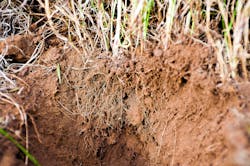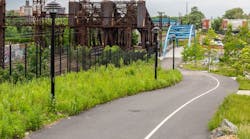Rupeet Malhotra is senior engineer and project manager for Stantec. Malhotra can be reached at [email protected].
undefinedSite stabilization is considered one of the most important aspects of controlling erosion from active or inactive construction zones. Sediment can often leave these sites by wind or water erosion. Left unchecked, pollutants attached to sediment make their way into our waterways through storm water and can cause undesirable impacts to water quality and ecology. Even on a site that lacks pollutants, additional sediment load carried to waterways through storm water flows can impact some aquatic species’ ability to reproduce. This is just one of the reasons it is most beneficial to control erosion at the source through timely stabilization of exposed areas, whether it is an active construction site, a site left inactive for a period or a site awaiting permanent stabilization measures to achieve closure of the site-specific construction general permit (CGP).
Construction activities often require clearing and grubbing of land to grade the sites and prepare for building activities. These activities leave the soil surface disturbed and exposed to the elements. Surface runoff, which is generated when rain falls on disturbed soil, mobilizes the loose sediment and can carry it a significant way from its origin point.
Temporary vs. Permanent Controls
Temporary soil stabilization is needed when construction is inactive for a period. For example, for a project in California, the CGP gives the following guidance: Inactive areas of construction are areas of construction activity that have been disturbed and are not scheduled to be re-disturbed for at least 14 days.
Many have had those projects where, at times, construction activities may be halted for a variety of reasons, but the risk to water quality remains. Therefore, effective soil cover needs to be maintained on all exposed surfaces. Temporary erosion control methods are employed in these cases, until the construction can resume or permanent stabilization can be achieved.
Temporary stabilization of disturbed soil can be achieved by:
- Wind erosion control through application of moisture by water trucks.
- Wind erosion control through application of hygroscopic suppressants, most commonly calcium and magnesium chloride. These suppressants, as the name suggests, attract and hold moisture from the air and keep the exposed surface area damp. While successful in humid parts of the country, hygroscopic suppressants provide limited benefit in arid areas of California and other western states due to the lack of moisture in the air for a majority of the year. Be aware that use of calcium- and magnesium-chloride-based suppressants results in storm water that has high specific conductivity and high salinity. Overuse of salts can also impact the ability to re-establish vegetation. The salts left behind can temporarily impact soil chemistry and impede growth of post-construction vegetation.
- Erosion control through chemical polymers that bind the soil particles together. Again, while binders work well, are easy to apply, and remain for a while, they are toxic to aquatic life.
- Erosion control through nature-based adhesives or plant-based binders. Plant-based binders are natural glues, such as guar and psyllium. Natural glues are biodegradable and generally non-toxic but more expensive compared to hygroscopic suppressants or chemical polymers. Bonded fiber matrix (BFM) is an example of an adhesive type of binder that holds the soil particles in place. Use of BFM is also effective for erosion control in advance of permanent stabilization (discussed later) as it holds the seeds in place and prevents seed loss until the root system of the planted vegetation can be established.
Non-vegetative stabilization measures, such as gravel, crushed rock, mulch and erosion control blankets/mats are found to be effective on both sloped and non-sloped surfaces.
Permanent stabilization of all disturbed areas is required to terminate coverage of the construction project. This will differ from state to state and locality to locality. In the instance of the previously mentioned California’s construction general permit, there are three main tenants to permit closure. The overarching requirement is a minimum 70% stabilization, documented either through visual observations and photo documentation or through calculations. According to Order Section II.D.1.a of the 2009-0009-DWQ (amended by 2010-0014-DWQ & 2012-0006-DWQ), a site has considered to have achieved final stabilization when the site will not pose any additional sediment discharge risk than it did prior to the commencement of construction activity.
This definition would include (1) elimination of the potential for discharge of construction-related pollutants, (2) removal of construction materials and wastes and construction related equipment, and (3) compliance with the post-construction standards in Section XIII if the general permit has been demonstrated and post-construction storm water management measures have been installed, plus a long-term maintenance plan has been established.
Furthermore, the discharger must demonstrate that final stabilization is achieved through (1) 70% final cover method, (2) Revised Universal Soil Loss Equation (RUSLE) or RUSLE2 computation, or (3) a custom method identified in advance by the discharger/permittee and accepted in advance by the regional water board. This could include permanent vegetation (grass) or non-vegetative cover (pavement, gravel, crushed rock or equivalent non-erosive cover) over more than 70% of the disturbed area. Also, demonstration through RUSLE calculations that the post construction conditions soil loss does not exceed the pre-construction conditions soil loss would work to satisfy requirements.
Overcoming the Barriers to Permanent Stabilization
Permanent stabilization can be achieved through establishment of vegetative cover or non-vegetative methods. Non-vegetative measures include placement of gravel, crushed rock or class II aggregate on the exposed surfaces to eliminate erosion potential.
Non-vegetative stabilization is relatively easy to achieve. The downside being that it is expensive and may require long term inspection and maintenance to make sure it does not require replacement. For instance, if materials like mulch are used for landscaped areas, erosion control measures will likely require periodic refreshment to continue providing protection.
Permanent stabilization through vegetation requires establishment of at least 70% of the pre-construction level of vegetation cover. Vegetation plays a crucial role in protection against wind and water erosion, but several challenges are presented in successful establishment of vegetation.
Establishment of vegetation is typically harder to achieve in inland areas compared to the coastal areas. If we look at inland California, weather cycles are characterized by hot, dry summers and cold winters, which provide challenging conditions for establishment of vegetation. California’s susceptibility to droughts exacerbates the hot, dry conditions that prevent germination of seeds and vegetation growth. In such conditions, specialized seed mixes, soil amendments and nutrients may be applied with the seeds to promote growth. Quality of the native soil is also a critical factor in achieving the necessary seed germination and growth. For example, in parts of the California desert, soil lacks the nutrients and organics that can supplement the natural environment and promote growth and overall plant health.
Soil amendments may be necessary in such areas and may present a challenge for large areas. The timing of hydroseeding is also an important consideration. Since seeds germinate in suitable weather conditions, it is key to properly time their application or protect and insulate the seed if it must be set during a time when germination may not be as favorable.
Site topography is another important consideration for vegetation establishment. Gentler slopes or flat areas may promote seed germination, whereas seeds may not establish with equal ease on slopes without the use of a binder. Successful establishment of vegetation requires thoughtful planning and scheduling at the onset of the project.
Tough Challenges, Timing May Not Always Be On Your Side
A construction site in San Joaquin County is an example where the dry conditions, coupled with poor timing of hydroseeding and use of a seed mix that requires high moisture during germination made conditions counterproductive to establishment of vegetation.
The project completed construction in March during the tail end of California’s shortened rainy season. The team awaited vegetation establishment for over two months, while continuing to monitor the site for compliance with the CGP. After two months, when vegetation did not start to establish, the seed was tested and found to have germinated and died. It was decided that a new, easier to grow, seed mix would be applied but also mixed with a binder to insulate it through the hot summer months. This would ensure that the seeds can start germination in the fall and permanent stabilization will be achieved during the California winter rains. Soil testing to test for presence of adequate amount on nutrients and organics conducive to seed germination and vegetation establishment was also recommended.
This project serves as an example of how careful planning and scheduling at the onset of the project may have saved time and money that was otherwise expended in the use of unsuitable seed mix and at the time of the year when germination rates are less than favorable.






